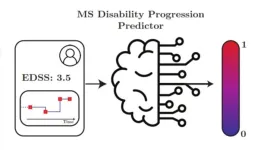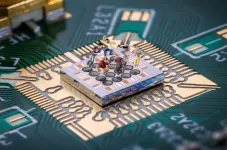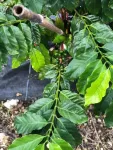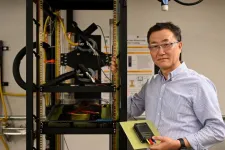(Press-News.org) Specific neurons in the brain’s zona incerta (ZI) play a crucial role in the early social interactions of an infant and its mother, building their bond and reducing stress, according to a new study in mice. Activation of the same neurons in adult mice increased anxiety- and fear-like responses, the study showed. In humans, as in other mammals, infants have an inborn tendency to form an attachment bond with their mothers or caregivers – a bond that plays a crucial role in the infant’s development. This bond helps newborns feel secure and serves as a safety net from which to explore their surroundings, learn, and develop crucial skills and behaviors. However, the neural mechanisms underlying these important social bonds during an infant’s development are not fully understood. Given an infant’s response to their mother requires the integration of diverse sensory inputs, the ZI – a brain region that serves as a node for both external and internal stimuli – may play an important role in this process. What’s more, previous research has shown that the ZI connects more densely to other brain regions early in life but retracts these connections after weaning.
In this study in preweaning mice, Yuexuan Li and colleagues investigated the role that neurons in the ZI play to integrate the early social experiences of the infant and facilitate a maternal bond. Using fiber photometry, Li et al. recorded the activity of ZI neurons in 16- to 18-day-old pups during interaction with their mother. They discovered that presence of the pup’s mother led to increased activity of somatostatin (SST)-expressing neurons in the ZI (ZISST), but not other types. Increased periods of social isolation between interactions with the mother did not change the activation response, suggesting that ZISST neurons track the presence of and direct interaction with the mother. Other forms of social interactions, including those with unfamiliar adults, peers, or siblings, also activated ZISST, but much more modestly. Moreover, ZISST neurons integrate sensory signals, such as olfactory and whisker inputs, to respond to social interactions. Removing both sensory inputs reduced activation, highlighting the importance of multisensory integration. According to the findings, a mother’s presence significantly influences infant behavior by reducing distress and stress hormone levels. Artificial activation of ZISST neurons mimics these calming effects during isolation. Li et al.’s results contrast with the effects of ZISST in adult mice, where activation of the same neurons increased anxiety- and fear-like responses, indicating that this neural circuit may adapt to support the distinct needs of individuals across development. “Our findings provide an entry point to study infant-specific responses during neurotypical and neurodivergent development,” write the authors.
END
Revealed: Neurons that help create infant-mother bonds in young mice
Summary author: Walter Beckwith
2024-07-25
ELSE PRESS RELEASES FROM THIS DATE:
Can a computer tell patients how their multiple sclerosis will progress?
2024-07-25
Machine learning models can reliably inform clinicians about the disability progression of multiple sclerosis, according to a new study published this week in the open-access journal PLOS Digital Health by Edward De Brouwer of KU Leuven, Belgium, and colleagues.
Multiple sclerosis (MS) is a chronic progressive autoimmune disease that leads to severe disability over time through a complex pattern of progression, recovery, and relapse. Its global prevalence has increased by more than 30% over the last decade. ...
Novel human lung organoids can form lifelike models for tuberculosis infection, and might be used to test efficacy of anti-TB drugs
2024-07-25
Novel human lung organoids can form lifelike models for tuberculosis infection, and might be used to test efficacy of anti-TB drugs.
####
Article URL: http://journals.plos.org/plospathogens/article?id=10.1371/journal. ppat.1012295
Article Title: Advances in an In Vitro Tuberculosis Infection Model Using Human Lung Organoids for Host-Directed Therapies
Author Countries: Republic of Korea
Funding: This research was supported by the Korea National Institutes of Health (NIH) (No. 2021-ER2001-00) awarded to E.M.K., the Korea Institute of Toxicology, Republic of Korea (No. 1711195891) awarded to E.M.K., the Korea Environment Industry & Technology ...
Spin qubits go trampolining
2024-07-25
Researchers at QuTech developed somersaulting spin qubits for universal quantum logic. This achievement may enable efficient control of large semiconductor qubit arrays. The research group published their demonstration of hopping spins in Nature Communications and their work on somersaulting spins in Science.
In 1998, Loss and DiVincenzo published the seminal work ‘quantum computation with quantum dots’. In their original work, hopping of spins was proposed as a basis for qubit logic, but an experimental implementation has remained lacking. After more than 20 years, experiments have caught up with theory. Researchers ...
Seven steps to achieving the right to clean indoor air post-pandemic
2024-07-25
Professor Morawska, director of THRIVE, from QUT’s School of School of Earth and Atmospheric Sciences said the rapid global spread of Covid-19 had soon made it clear the world was unprepared to respond appropriately.
“In the early days of the pandemic the World Health Organisation and many national health authorities claimed the virus was ‘not in the air’ but rather present in large quantities on surfaces. This led to a misconception about how the virus was transmitted,” ...
Scientists study how to bring you ‘climate-smart coffee’
2024-07-25
Crave that cup of coffee in the morning? Globally, consumers drink more than 2.2 billion cups daily. Someone grows all that joe: More than 100 million farmers worldwide produce coffee.
Coffee beans consumed across the globe come from two species: Coffea arabica and Coffea canephora, also known as Robusta (or Conilon) coffee. Historically, coffee drinkers prefer Arabica beans for their specific flavor and aroma, said Felipe Ferrao, a University of Florida research assistant scientist in horticultural sciences.
But by 2050, about 80% of Arabica production is predicted to decrease because of climate change. So, Ferrao and colleagues from France (RD2 Vision) and Brazil (Incaper ...
New study shows at-home colon cancer screening test reduces risk of colorectal cancer death, as effective as screening colonoscopy
2024-07-25
COLUMBUS, Ohio – A noninvasive colorectal cancer screening test that can be done at home could reduce the risk of colorectal cancer death by 33%, according to a new study published in JAMA Network Open. This is the first study to evaluate this tool’s effectiveness in specific racial groups.
For this study, researchers at The Ohio State University Comprehensive Cancer Center – Arthur G. James Cancer Hospital and the Richard J. Solove Research Institute (OSUCCC – James), and Kaiser Permanente evaluated data from nearly 11,000 patients who underwent at-home FIT (fecal immunochemical testing) among ...
A cool solution
2024-07-25
Artificial intelligence (AI) is hot right now. Also hot: the data centers that power the technology. And keeping those centers cool requires a tremendous amount of energy.
The problem is only going to grow as high-powered AI-based computers and devices become commonplace. That’s why University of Missouri researcher Chanwoo Park is devising a new type of cooling system that promises to dramatically reduce energy demands.
“Cooling and chip manufacturing go hand-in-hand,” said Park, a professor of mechanical and aerospace engineering in the Mizzou College of Engineering. “Without proper cooling, components overheat and fail. Energy-efficient data centers will be key ...
Electrical currents may make body’s cancer-killing cells even better killers
2024-07-25
Scientists have discovered that electrical currents may make Natural Killer (NK) cells – our very own cancer-killing immune cells – even better killers, which could have significant implications for treating some cancers.
The scientists found that Tumour Treating Fields (TTF) in the laboratory (which mimic exposure of brain tumours to electric currents via a simple hat worn by patients) evoked an even more deadly response from NK cells. They hope their promising findings may open the door to new combined therapies for people living with certain brain tumours, such as glioblastoma.
Glioblastoma is an aggressive, common ...
In Illinois, ‘older adults are at increased risk for suicide’
2024-07-25
Most (83%) suicide deaths were among men
Firearms were the most frequently used weapon (59%)
Among those who died by suicide, 20% had been diagnosed with depression; only 14.1% of them were receiving treatment
CHICAGO --- Nearly 20% of suicides in Illinois between 2020 and 2021 were among people 65 years and older, according to recently released data from Northwestern University Feinberg School of Medicine. The suicides disproportionately affected white men between the ages of 65 and 74 years, with ...
Raindrops grow with turbulence in clouds
2024-07-25
Scientists for decades have attempted to learn more about the complex and mysterious chain of events by which tiny droplets in clouds grow large enough to begin falling toward the ground. Better understanding this process, known as the “rain formation bottleneck,” is fundamental to improving computer model simulations of weather and climate and ultimately generating better forecasts.
Now a research team led by scientists at the U.S. National Science Foundation National Center for Atmospheric Research (NSF NCAR) ...
LAST 30 PRESS RELEASES:
Chicago health information leader recognized for raising CPR readiness and blood pressure awareness
The Intimate Animal, a new book from Kinsey Institute Executive Director Dr. Justin Garcia
When blue-collar workers lose union protection, they try self-employment
New video dataset to advance AI for health care
MEA-based graph deviation network for early autism syndrome signatures in human forebrain organoids
New modeling approach sheds light on rare gut disease
Study documents potentially hazardous flame retardants in firefighter gear
Can certain bacteria regulate aging of the immune system and its related alterations?
AI model helps diagnose often undetected heart disease from simple EKG
There are fewer online trolls than people think
Cell membrane fluctuations produce electricity
Jeonbuk National University study shows positive parenting can protect adolescents against self-harm
Surface-engineered ZnO nanocrystals to tackle perfluoroalkyl substance contamination
This new understanding of T cell receptors may improve cancer immunotherapies
A new fossil face sheds light on early migrations of ancient human ancestor
A new immunotherapy approach could work for many types of cancer
A new way to diagnose deadly lung infections and save lives
40 percent of MRI signals do not correspond to actual brain activity
How brain-inspired algorithms could drive down AI energy costs
Gum disease may be linked to plaque buildup in arteries, higher risk of major CVD events
Contrails are a major driver of aviation’s climate impact
Structure of dopamine-releasing neurons relates to the type of circuits they form for smell-processing
Reducing social isolation protects the brain in later life
Keeping the heart healthy increases longevity even after cancer
Young adults commonly mix cannabis with nicotine and tobacco
Comprehensive review illuminates tau protein's dual nature in brain health, disease, and emerging psychiatric connections
Book prepares K-12 leaders for the next public health crisis
Storms in the Southern Ocean mitigates global warming
Seals on the move: Research reveals key data for offshore development and international ecology
Sports injuries sustained during your period might be more severe
[Press-News.org] Revealed: Neurons that help create infant-mother bonds in young miceSummary author: Walter Beckwith



